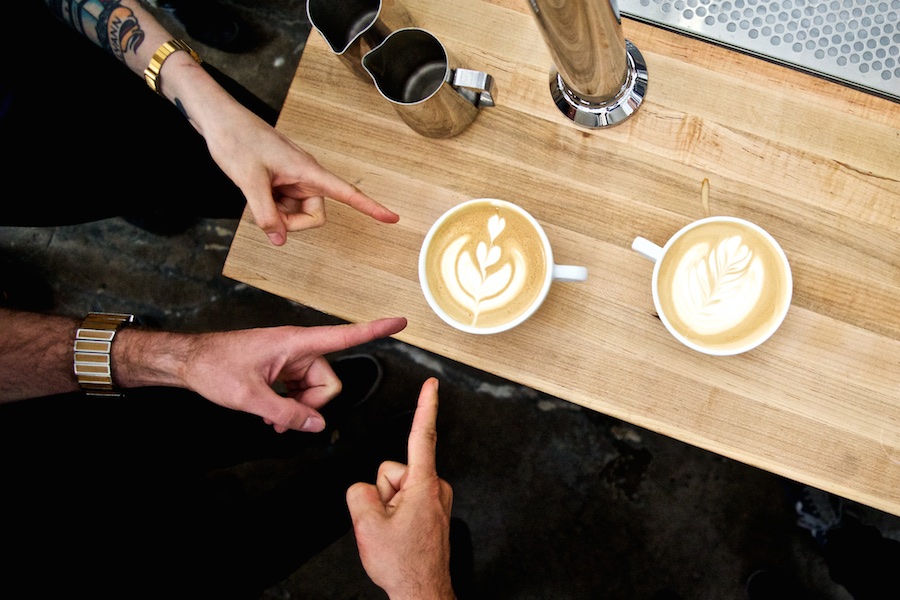Last month, 32 baristas converged upon Industry City for the city’s largest latte art throwdown to date, each one pouring against successive head-to-head opponents. The afternoon was a veritable clash of coffee titans fighting tooth and nail for latte supremacy, or rather, an enjoyable gathering of talented baristas from around the city having a bit of fun with their work on a Saturday. Either way, they were competing to win a $1,000 grand prize, or as organizer Ashkan Zandieh described it, “one month’s rent.”
The competition was held as part of the larger, daylong CoffeeOne industry gathering, which featured offerings from the likes of BÚÐIN, Poursteady, Sweetleaf (whose free, vanilla mini-donuts were a definite highlight of the day), and Boston’s George Howell Coffee, plus workshops, including a particularly informative one on AeroPress from Toby’s Estate. CoffeeOne was the inaugural event for New York Coffee Week, a group founded by Zandieh, founder of the real estate consulting startup RE:TEch; Emma Blankinship, Coffee Director at the Wythe Hotel; and Todd Schmiedlin, BÚÐIN’s general manager.
The throwdown’s rules were fairly simple, make “whatever you think will impress.” Two competitors at a time poured their lattes into cups of differing size, depending on the round. Split shots made from 28 grams of Parlor Coffee’s Stockist Blend were used for each pour. Each round was judged by Parlor Coffee’s A.J. Walzer, Stumptown’s Jaime Hodgkin and Blankinship. The espresso system itself was provided by Modbar, an event sponsor whose machine was chosen, because it has no back, according to Zandieh, which prevents competitors from hiding their work, and allows spectators to see the action.
Most designs featured the standard array of rosettas and hearts, which forced at least one of the judges make her decisions based on crucial details.
“I look for the texture of the milk, and if it’s smooth, and will live beyond a few seconds, in terms of the smoothness. I look for dexterity in the pour, and whether or not there’s intention behind what’s been done, instead of just like, sometimes when you pour any kind of milk art, you’re just like, you shake your wrist and something happens and that’s what it is, “ said Blankinship. “But when you can really see someone that’s really good at what they’re doing, you can see they have a plan of attack. And I look for complexity in the design. If it’s just one solid rosetta, that’s one thing, but when you can see there’s many layers. I look for symmetry, and the use of the circle of the space. It could be a really complex and interesting design, but if you can see it’s accidentally crammed to one side, it just looks prettier to have something be really centered and intentional.”
However, judging was still largely subjective, based mostly on judges’ personal preferences.
“There’s no criteria, not for me in particular. I am just looking for symmetry and texture and creativity,” Walzer added.
“I think having a latte competition is about being forced to do something well under any circumstance. Being a master of your craft means you can make something look great under any situation,” said Blankinship.
Another crucial feature of the competition were the coffee cups themselves, which varied in size from 12 oz. to 6 oz., depending on the round. That variation can have a tremendous effect on the pouring technique, the final latte and the entertainment value for the 50 — 60 spectators in attendance.
“I think having a latte competition is about being forced to do something well under any circumstance. Being a master of your craft means you can make something look great under any situation,” said Blankinship. “It’s easier to do a larger size because you have more time to adjust, you have more room to do more complex artwork. We thought about doing a small demitasse cup for the finale, but we thought that would be boring because of how challenging it is. It would just be a matter of overcoming stress rather than being artistically capable.”

The eventual winner, Kelsey Ford, who works at Brooklyn Roasting Company and has been pouring lattes for six years, was mostly just elated with her win. “I feel blown away, I don’t even know how it happened. I kinda poured a little janky all day, so the fact that I’m standing here with money in my hand is kinda crazy.”
Ultimately, the event’s organizers seemed mostly happy with a successful event, and excited for what the future hold for New York Coffee Week. In November, they’ll host a full Coffee Week with tastings and events at cafes around the city, culminating with another CoffeeOne event.
“We just wanted do something fun and collaborative with the coffee industry. We’ve got Budin on board, we’ve got Sweetleaf, and one by one, everyone started coming together, and we told them that we wanted to do a fun community event to showcase New York companies, and lo and behold, here we are today,” said Zandieh. “This is a huge success for us because there has never been a $1,000 latte art competition for a localized event.”



